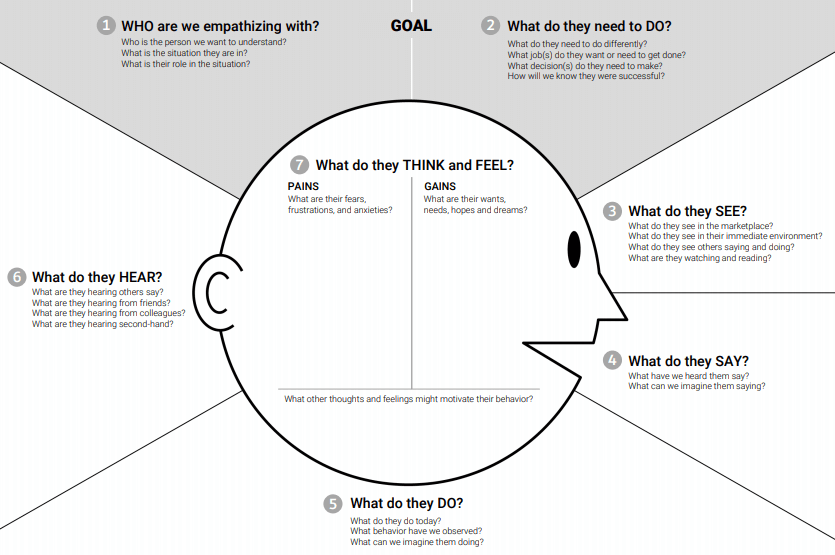The process of creating intuitive digital designs involves the creative skills of designers with a focus on fulfilling user needs. A common theme that occurs in websites and apps with low adoption issues is a failure to address user needs.
Dave Gray, the founder of XPLANE, introduced ‘Empathy Maps’ as a human-centric tool to understand user needs on a deeper level. Dave observed that users’ thoughts and actions are often miscommunicated causing the design to fail miserably. He used empathy maps as a medium to visualize user needs effectively. It is now a popular methodology for UX researchers to create designs around user needs. Leading UX UI Consulting services providers use empathy mapping as a tool to address user experience challenges.
This blog post explores how empathy mapping is essential for building engaging digital products.
Introduction to Empathy Mapping and its Significance
An empathy map is a visual description of user needs, activities, and experience in relation to product design. Traditional empathy maps follow a “Say | Think | Does | Feel” approach with pre-defined user personas at the center. It is, therefore, important for UX researchers to frame realistic user personas before producing empathy maps.
The user personas are critical for framing contextual questions to generate rich insights about user behavior and experience. The user needs and experience inputs gathered by UX research consultants through empathy mapping lead to engaging digital products.
More recently, Dave Gray developed a revised version of typical empathy maps. It includes additional fields such as “Who” and “Do” to further clarify the context and purpose of user activity. Here is the new version of Dave’s empathy maps-

Dave explains, “Empathy maps help teams develop deep, shared understanding and empathy for other people. People use it to help them improve customer experience, to navigate organizational politics, to design better work environments, and a host of other things.”
How to Frame Useful Empathy Maps for your Organisation?
Here is a quick factual example that businesses can refer for building workable empathy maps-

Step 1- Define Goals
The Goal section in an empathy map includes two major inputs-
1) The subject of the empathy map, his bio, prevailing situation.
2) The subject’s activities, decisions, and needs pertaining to the product.
Basically, the first step serves as an introduction to the user’s profile, his circumstances, and his overall needs. Consequently, it enables businesses to categorize users with a similar background and needs to ease the designing process.
Step 2- What do they See?
The essence of UX consulting activities is to gain a precise understanding of the end users’ perspective. At this stage, UX consultants must broaden their perspective to perceive the pain points and motivations of end users.
The aim is to identify the things, messages, symbols, and inspirations that users recognize. Furthermore, market scenarios and references from the competitive environment can be used to gain a better understanding.
Step 3- What Do They Say vs What They Do?
The discrepancy between user statements and user actions is an unavoidable human flaw. Misinterpreting users’ words as their final decisions can be counterproductive. Industry giants including Wallmart have faced the brunt of miscalculating user decisions.
It is, therefore, critical for UX researchers to ask the right questions and verify the answers with the users’ respective actions. It enables businesses to extract meaningful and well-defined insights about what the user needs versus what he actually does. The step may also cover what all does a user know and hear about the product from their immediate surroundings.
Step 4- What do they experience?
It is one of the most important aspects of empathy mapping. Learning about how a user thinks and feels about the product adds significant value to the design. It enables businesses to understand user expectations and challenges in accessing the product through design.
Above all, UX research consultants should be flexible while executing this last step as user experience is bound to change with time. Therefore, an iterative methodology should be undertaken to design timeless and effective digital interfaces.
You may also like to read- 10 UX Research Techniques and their Significance
Industry Appropriate UX UI Consulting Services
The UX research consultants at Oodles Studio conduct in-depth research about the digital requirements of multiple industry businesses across the globe. Our UX research services include definite User Personas, Competitive Analysis Reports, Information Architecture Diagrams, and other UX reports. Talk to our UX/UI design team to build intuitive and effective digital interfaces for your business.
Image Source- Google



